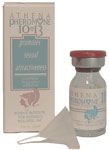
Misclassification rates in breast histopathology biopsies: how can they be lowered?
©Menopause Live, February 2017. An e-newsletter of the International Menopause Society.
Winnifred Cutler, Ph.D., Athena Institute for Women's Wellness, Chester Springs, PA.
and
James Kolter, M.D., Philadelphia College of Osteopathic Medicine, Philadelphia, PA, USA
This e-letter provides commentaries on recently published scientific papers that may be of interest to the members of the International Menopause Society. The opinions expressed in these commentaries are those of the commentary authors and are not necessarily supported by the IMS.
Date of release: 13 February, 2017
Misclassification rates in breast histopathology biopsies: how can they be lowered?
Because misclassification of breast biopsies is relatively common, and no prior study had analyzed strategies for reducing error, the recent Elmore study is timely [1]. Here, 12 different strategies for acquiring second opinions were compared in order to help define which strategies worked best to reduce misclassification errors. The authors systematically tested whether and which pathology classification affected the best strategic choice for: invasive breast cancer, ductal carcinoma in situ (DCIS), atypia, proliferative without atypia, or benign without atypia. Also analyzed was the influence of the perceived case difficulty, the pathologists' clinical volumes, and local institutional policy.
The test sample consisted of a set of 240 histopathology slides (one per case) that had previously undergone expert consensus to form a reference diagnosis. A total of 115 pathologists were assigned to one of four groups of 60 slides distributed according to the range of outcomes usually found. Each pathologist independently interpreted all 60 slides from one of the four sets of 60 breast biopsy specimens. The key findings were: (1) Over-interpretation of benign cases without atypia was cut in half (12.9% to 6.0%) by second opinions when initial diagnosis of atypia, DCIS and invasive cancer always included a second opinion; (2) atypia cases had the highest misclassification rate after a single interpretation (52.2%) which remained at more than 34% in every second opinion strategy tested; (3) excluding invasive breast cancer slides, the misclassification rates decreased (p < 0.001) from 24.7% to 18% when all of these received a second opinion; (4) high-volume pathologists (> nine cases per week) consistently delivered fewer misclassifications; (5) accuracy of diagnosis improved by the second opinion regardless of the pathologists' confidence in their experience or diagnosis.
Comment
Because of widespread use of mass screenings in the last 20 years, concomitant increases in DCIS, atypia, proliferative without atypia and invasive breast cancer have been recorded. Unfortunately, invasive cancers that might never have been detected or caused harm have been estimated at about one-third of all new cases in women [2-5].
The present study has acknowledged its limitation in that only one slide per case is shown. But it forcefully clarifies the value of second opinions in reducing misclassification errors, and to identifying 'experienced' pathologists who are doing the readings. Unfortunately, second opinions are not commonly required by the institutions for the conditions with the highest misclassification rates.
According to a recent population-based case-control study of major coronary events in Denmark and Sweden, exposure of the heart to ionizing radiation during radiotherapy for breast cancer increases the subsequent rate of ischemic heart disease by an average of 37%. The increase in rate of ischemic heart disease is proportional to the mean dose to the heart and can more than double a woman's risk for cardiac mortality. The increased rate begins within a few years after exposure, and continues for at least 20 years. Women with pre-existing cardiac risk factors have greater absolute increases in risk from radiotherapy than other women [6].
Consequently, reducing breast biopsy misclassifications can alter, in patients' favor, the balance between the benefits of evidence-based treatment for breast cancer pathologies and the body-wide harms that unneeded treatments will generate.
References
Elmore JG, Tosteson AN, Pepe MS, Longton GM, Nelson HD. Evaluation of 12 strategies for obtaining second opinions to improve interpretation of breast histopathology: simulation study. BMJ 2016;353:i3069
http://www.ncbi.nlm.nih.gov/pubmed/27334105
Jorgensen KJ, Gotzsche PC. Overdiagnosis in publicly organized mammography screening programmes: systematic review of incidence trends. BMJ 2009;339:1-8
http://www.ncbi.nlm.nih.gov/pubmed/19589821
Gilbert Welch HG, Prorok PC, O'Malley AJ, Kramer BS. Breast-cancer tumor size, overdiagnosis, and mammography screening effectiveness. N Engl J Med 2016;375:1438-47
http://www.ncbi.nlm.nih.gov/pubmed/27732805
Jorgensen KJ, G?tzsche PC, Kalager M, Zahl PH. Breast cancer screening in Denmark: a cohort study of tumor size and overdiagnosis. Ann Intern Med 2017 Jan 10. Epub ahead of print
http://www.ncbi.nlm.nih.gov/pubmed/28114661
Brawley OW. Accepting the existence of breast cancer overdiagnosis. Ann Intern Med 2017 Jan 10. Epub ahead of print
http://www.ncbi.nlm.nih.gov/pubmed/28114628
Darby SC, Ewertz M, McGale P, et al. Risk of ischemic heart disease in women after radiotherapy for breast cancer. N Engl J Med 2013;368:987-98
http://www.ncbi.nlm.nih.gov/pubmed/23484825
Dr. Cutler's pheromone science has been "bottled" into vials of unscented fragrance additives that increase wearers' sexual attractiveness. AVAILABLE FOR PURCHASE HERE
*Related book by Dr. Cutler: Hormones and Your Health

